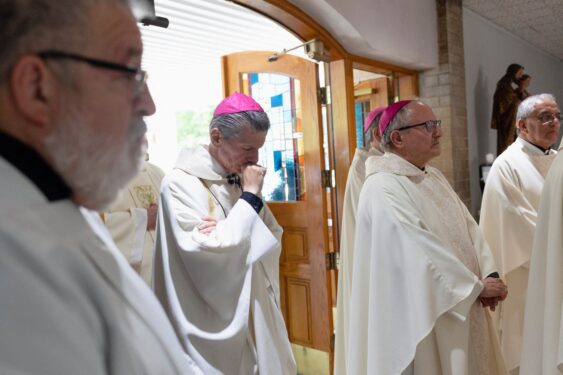
PROSPECT HEIGHTS — Celebrating a Mass for the Uvalde, Texas community on the first night after the Robb Elementary School shooting, Archbishop Gustavo García-Siller called the children in attendance to the front of the church to speak with them directly, but didn’t receive any feedback.
At that moment, the archbishop of San Antonio knew he needed a way to communicate with the children other than the spoken word. After asking the Holy Spirit for guidance, he decided to try sign language, which he had taken up a few months earlier, but knew only a few words.
Archbishop García-Siller then started signing messages to children related to peace, which they eventually mimicked. Days later, at another special intention Mass following the May 24 shooting, Archbishop García-Siller again called the children up to the front of the church and taught them the words “peace,” “love,” and “Holy Spirit” in sign language.
“Sometimes we don’t know what to say, how to console people, express how we feel, and so sometimes we can just do the signs and live a day at a time,” Archbishop García-Siller told The Tablet after the Mass.
The archbishop’s intention for learning sign language this past spring was to serve the archdiocese’s deaf community. As it turns out, it also helped him navigate multiple crises this summer.
First, it was the Uvalde shooting, where 21 people were killed. Then in June, after 53 migrants were found dead in an abandoned tractor-trailer on the outskirts of San Antonio, he used sign language to say words like “love” and “thank you” to the survivors he visited in the hospital.
Now, months after those tragedies, Archbishop García-Siller continues to use and learn sign language. It’s something he expects will continue to be a part of Catholic life for all parishioners in the archdiocese.
“Not only for the deaf, but sometimes we don’t know how to communicate, and sign language could be a great vehicle because it’s based in words and letters, but also with symbols, with signs, and we can connect in great ways,” Archbishop García-Siller said. “It’s been a tremendous thing, and I am very excited.”
“It has caused a very powerful reaction,” he continued. “The sense that we are communicating, that we are in touch, that in some way you’re building a bridge for people to express what they’re going through.”
The archbishop’s desire to learn sign language also came from his recognition that celebrations in the archdiocese often included interpreters for deaf parishioners and that “if we want to really include them, they need to know that I want to communicate with them more directly.
“The motivation was the needs of the people and to communicate with them, and to understand them because understanding them makes it easier to communicate, and if they are speaking in sign language to me, if I don’t understand them, it will not be a good service on my part,” Archbishop García-Siller said.
When his sign language classes began, the instructors were going to start by teaching him his name. He instead chose, somewhat providentially given future circumstances, to learn the word peace, explaining to The Tablet that he believes that his call is to be an instrument of peace.
Effective Sept. 25, Our Lady of Sorrows Catholic Church is the home parish for the deaf community in the archdiocese, where Archbishop García-Siller and others will preach and minister. In announcing the designation in late August, the church’s pastor, Father José Ramón Pérez-Martínez, said that by this, the church “intends to strengthen the accommodation and resources for the deaf community.”
For the rest of the archdiocese, Archbishop García-Siller continues to explore when and how to appropriately incorporate sign language into Mass. He highlighted that it’s beneficial when engaging children in moments where there is a dialogue or call and response and during the homily.
He noted he has also seen the benefit of using sign language during a bilingual Mass because it allows him to reach both the Spanish and English-speaking communities, as well as the deaf community. It connects the parishioners, and he doesn’t have to repeat the same thing in three languages.
Archbishop García-Siller emphasized, though, that the main objective of sign language is to serve the deaf community.
“The main point has to be it’s a language of people that we need to honor and serve,” Archbishop García-Siller said. “That is your objective, and as a consequence, it can build up unity — you can connect people in crisis.”

